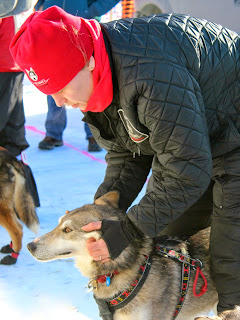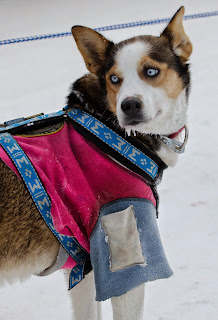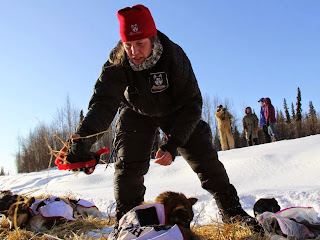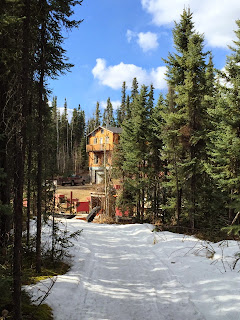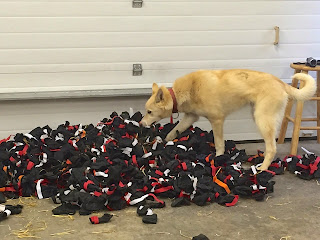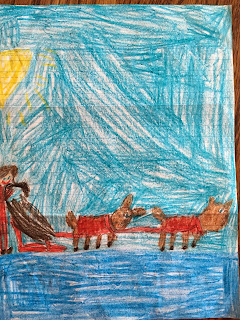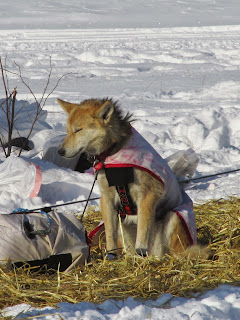Happy 14th Birthday ChaCha!
The successes that SP Kennel has had over the last few years have been partially due to very selective combination of genetics. The dog that has contributed most to the successful SP Kennel gene pool is ChaCha.
These days, ChaCha surveys the dog yard from her prime position on her dog bed in the lounge or outside from the deck. She has a “coffee table crate” in the lounge where she sleeps during the day and goes upstairs to Aliy and Allen’s room at night.
There was a time, not too long ago when she was the kennel’s top racing dog and “Queen of All The Things” (just quietly, she really is still the Queen of All The Things despite what Quito thinks). ChaCha has an attitude the size of Alaska with a heart to match. Aliy uses the word “sassy” often when describing her.
Currently ChaCha has a dozen of her children and 25 grand children on the Dogs and Puppies rosters. Can you pick them all?


Cha’s “coffee table crate” in the lounge; upstairs during the night
ChaCha was born at Husky Homestead in the summer of 2001. Her mother, Alberta, whelped the ‘Dances’ litter: Rhumba, Lindy, Tango and ChaCha. Her father, Yuski, was originally born at Susan Butcher’s kennel.
ChaCha ran Iditarod eight times, won multiple mid distance races and was SP Kennel’s ‘go to’ lead dog for many years. She has always been smart, fast and ultra competitive. She would bark outloud for miles when she was excited or if she saw competition ahead of her. ChaCha is also exceptionally friendly and sweet. She wags her tail at everyone and kisses anyone who will let her. Even more amazing is the fact that during her successful years as a sled dog athlete she also had four litters for a total of 25 puppies. For the past six years, her puppies have been the core of every SP Kennel team. They are well known because they are smaller, happy and fast!
When the idea for a Kennel All-Stars page was first formed there were several dogs that immediately came to mind. ChaCha is one of these dogs. Quite simply, she is one-in-a-million!
There are few framed photos in Aliy and Allen’s kitchen but one that has pride of place is this one (right) of ChaCha with her son Dingle at the start of 2011 Iditarod. It makes us all smile whenever we see it, such is the joy on both faces.
Back in 2003-4 Randy Chappel was training and racing at SP Kennel and one of the dogs on his team was a two year old he purchased from Husky Homestead. Here’s Randy’s story:
In the summer of 2003, I was coming off a 29th place Iditarod finish as a rookie under the fantastic tutelage of Aliy and Allen. In an effort to add a few dogs for 2004, I headed south from Two Rivers down to Jeff King’s place near Denali in my dog truck. He had put out a list of some dogs for sale, and I had a certain older leader in mind that I hoped could help out my 2004 Iditarod run. Unfortunately, when I got there, that dog and a couple others I had been thinking about had already been sold.
Well, I had driven a long way with cash in pocket and I really didn’t want to go home empty handed. And, I guess Jeff sensed that as well, as he thought for a while and then said he had one other dog that hadn’t really been for sale that maybe I would be interested in. This dog had great bloodlines but had spent her whole yearling season in some kind of a cast, unable to run. As I recall, she had just recently had the cast off. Anyway, he took this little 35 pound girl for a very short run with me, and then said he would sell her to me. Without thinking, and being intent on not coming home completely empty-handed, I forked over the cash. And, that was how I came to own ChaCha. Instead of the highly experienced 6 or 7 year-old good sized leader and a couple team dogs I had come intending to buy, I instead found myself loading my dog truck with just one dog – a barely two year old, tiny dog that had been injured her entire adult life to that point and never been down any race trail ever. Who knew if she would recover in time for my 2004 run? Who knew if she would recover EVER?
As I turned north on the Parks Highway to begin my 150 mile trip back home, buyer’s remorse started to set in, big time. I sheepishly called Aliy on my cell and explained what I had just done. “Broken leg all last year, huh?” she said. “Yep,” I replied. She asked about ChaCha’s bloodlines, which she immediately told me were fantastic, and then asked, “Is she spayed?” and I said, “Um, no.” Aliy said – “Well, you may have gotten lucky there. Jeff really never sells dogs with those bloodlines without spaying them or neutering them first.” Then Aliy summarized the whole deal with this: “Well you either just made the dumbest dog purchase you’ll ever make or the smartest dog purchase you’ll ever make – we shall see!” Of course, as time has shown, it was the luckiest, best dog purchase I ever made.
ChaCha immediately showed her amazing attitude, great speed, and despite her previous injury problems – she was always healthy! ChaCha really emerged at the 2004 Knik 200 in which I finished 5th, only 32 minutes behind the winner, Ryan Redington and only 29 minutes behind Aliy who finished second. I had no business finishing that far up, but ChaCha drove my whole team forward and demanded the rest of them keep up. At the finish line she was as happy as could be and ready for more, while my other leader, 8 year old Jazz looked relieved and exhausted as he laid down right as we crossed the finish line and looked at ChaCha like, “What the heck? Where did this youngster come from and why is she making us go so fast?”
A couple months later during Iditarod 2004, still as a two year old, she then led us in single lead across the Norton Sound from Shaktoolik to Koyuk when the rest of the team and I were really struggling. A star was born. The next year I moved back to Texas and ChaCha went to live with Aliy and Allen and the rest is history!
Congratulations and many thanks from me to ChaCha! – Randy
Kennel Mom Mickey has a special affinity with the other Kennel Mom ChaCha. She shares a particular memory from 2007:
I do have a vivid memory of her a few days before she delivered the Car Litter, her second litter. Cute little Cha Cha face, a wagging tail and strong little legs that looked like toothpicks under her huge balloon body. I was afraid she would burst before those pups came out the proper way. Finally she produced 8 pups out of that petite body. One mom putting herself in another mom’s shoes. We were both relieved when delivery was over.
Below is a “Meet the Dogs” video from November 2008 with Cha as a seven year old superstar at the top of her game.
Congratulations ChaCha from all of us on your induction into the SP Kennel All-Stars Hall of Fame. You deserve it. Good girl!
Click the button below to go to the SP Kennel All Stars page!








